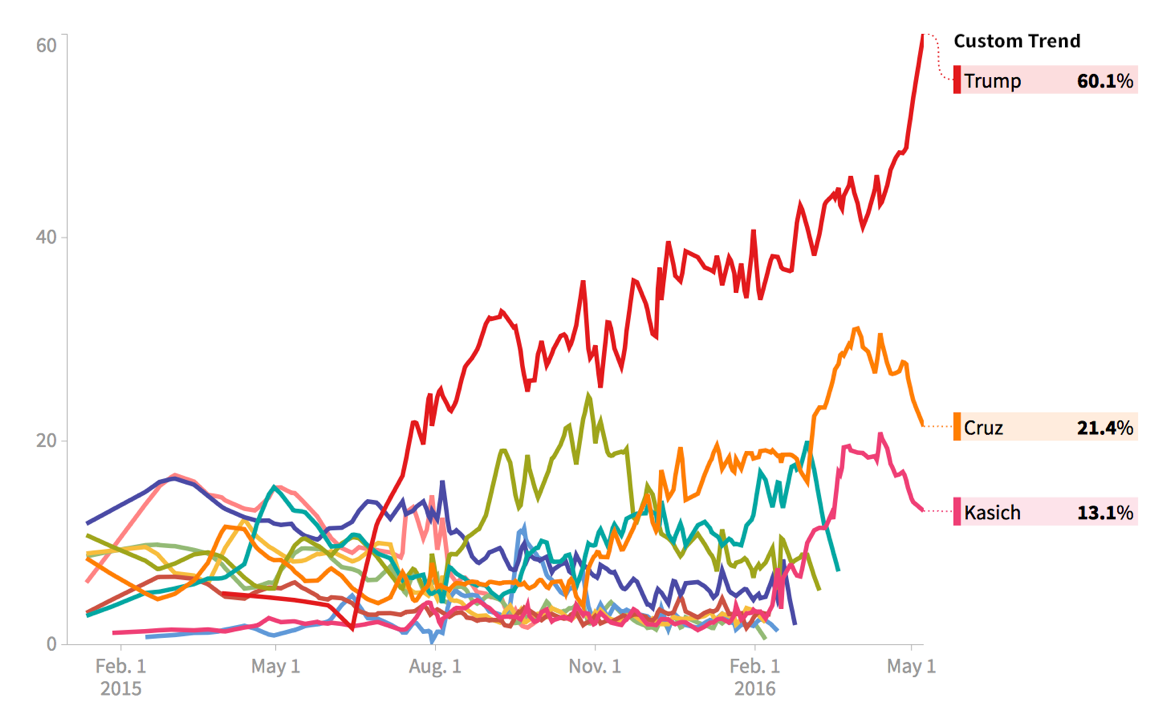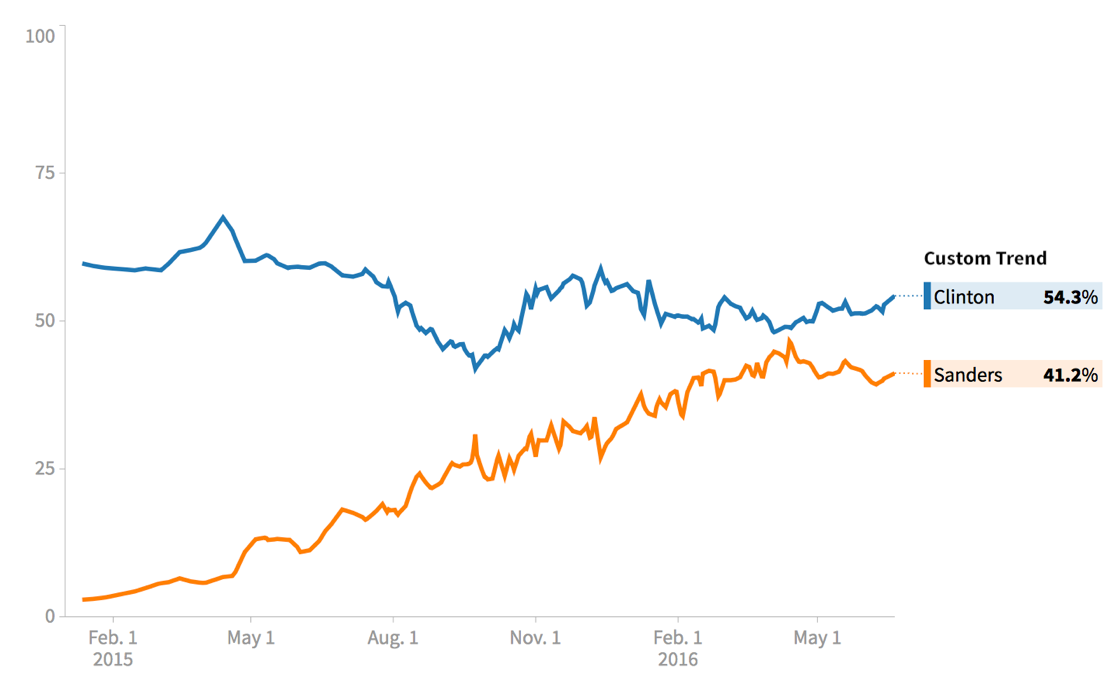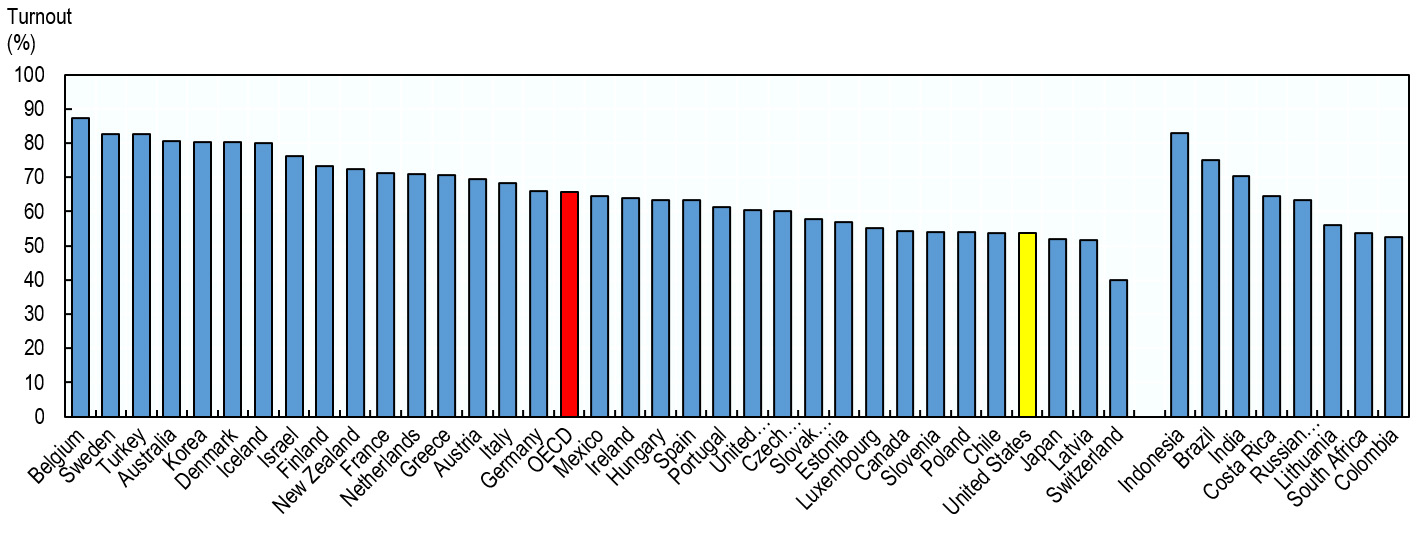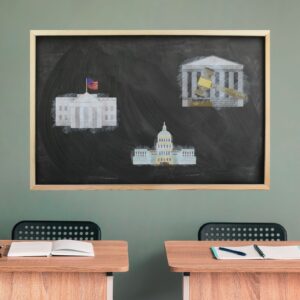Almost 650 days have passed since Hillary Clinton announced her candidacy for the Presidency. Nearly 550 since President-elect Donald Trump did the same. More than a year and a half since this competition started, I cannot believe it is finally over and Donald Trump has been inaugurated as President. Certainly, the results were shocking for most of us: for the campaigns, for the pollsters, and for the pundits, among others.
Since my arrival at Cornell, I was excited to become a direct witness of a US Presidential Election. American elections are important news events all over the world, and they also were in my country (Chile). I remember watching the debates between George Bush and Al Gore in 2000, or the historic election of President Obama and the memorable speeches he delivered during his campaign in 2008. However, this time I have had the privilege to understand and follow the process in the first person.
Disclaimer: this account is by no means exhaustive, nor does it pretend to include every aspect of the US Presidential election. The goal of this article is not to talk about the result of the election. My aim is to draw on the main characteristics that, in my view, allow the US Presidential election to be one the most comprehensive political vetting process for any candidate in the world.
Why do I believe Americans had one of the most comprehensive vetting processes that a Presidential candidate can experience?
First, the candidate selection process
Although primaries are the method that many countries choose to select presidential candidates, it seems unusual to have such a large number of candidates seeking to represent their parties. For example, in the recent primary elections in France for the right and the center, only seven candidates were on the ballot; in Chile, in 2013, only two candidates competed in the right and four candidates in the left.
In the United States, on the Republican side, 17 candidates were part of the process and many of them stayed in the race almost until the end. In Iowa, the first primary election, 12 candidates were officially in the republican ballot. On the Democratic side, initially there were five candidates, but the real contest was between Hillary Clinton and Bernie Sanders, after Governor O´Malley dropped out of the race following the results of the Iowa primary. The candidates’ backgrounds were varied: candidates boasted a range of professional experiences as, for example, Senators, Governors, former Secretary of State, businessman, and neurosurgeon.
Primaries were not an easy contest—not even for Hillary Clinton, who initially seemed to have a significant advantage within the Democratic Party. The tenor of the primary campaigns foreshadowed that of the general election: increasing disputes over issues, character attacks, ads were focused on competitors’ lack of qualification, and disputed debates set the tone for this ongoing process. Additionally, one key factor was the duration of the primary campaign: in the democratic side the first candidates started campaigning at the beginning of 2015; in the republican side the first candidate to announce his intention was Ted Cruz in march 2015.
The long and hard-fought campaign allowed Senator Sanders to reduce the distance with frontrunner Hillary Clinton and almost catching her in the end. The primaries also allowed the surge of Donald Trump within the Republican Party. Although candidates such as Senators Marco Rubio and Ted Cruz and Governors Jeb Bush, Chris Christie, and Scott Walker had positioned themselves to lead the polls, the atomization of preferences and the division within the party, allowed an outsider like Trump to prevail in the end.
In a comparative perspective, although primaries are increasingly being incorporated[1] as part of the electoral process in different countries, they are not as long as the American process. For example, in Canada, the overall election process lasted only 78 days and in Denmark, only three weeks. In other countries, such as the United Kingdom, internal contests are organized by the parties to select party leaders, but the electoral process itself is very brief. I believe that a longer process although it fosters more competition, it also allows a greater scrutiny of each candidate

This is the progression of the average polls for the Republican Primary race. The Republicans started the primaries without a clear frontrunner, and finally Donald Trump benefited from this divided vote. Source: HuffPost Pollster

This is the progression of the average polls for the Democratic Primary race. Although Hillary Clinton started as a clear favorite, Bernie Sanders narrowed the difference and almost tied her. Source: HuffPost Pollster
Secondly, the rallies and the political environment
I had the chance to go to three political rallies during the primaries (featuring Trump, Clinton, and Sanders) and I was surprised by the intense activity that candidates and people showed at these events. Thousands of people waiting in line to see the candidates, powerful speeches that highlighted the critical positions in their campaigns, and strong positioning against their rivals were some of the key aspects I experienced. As a contrast, in my country I have participated in many political rallies and increasingly the interest of people in political activity seems to be decreasing and party identification at an all-time low.
In an era of low political engagement, it is a positive thing for democracy and participation to see how the candidates are able to gather public support and provide spaces and platforms to discuss political and policy issues.
Another relevant factor was the behavior at the rallies. To attend a rally, you had to register online for tickets; at the rally, you could see, hear, and approach the candidates. Although there were reports of violence at some rallies, I do not believe it was commonplace for most of them, considering the huge crowds different candidates attracted all over the country. Reports have shown an increase in arrests and violence in rallies compared to other years, but still they are not significant considering how many events and people participated. In my experience, I saw people respectfully protesting at adversaries’ rallies without any significant commotion.

Thousands wait in line early in the morning to enter a rally with Bernie Sanders in Binghamton, New York. Source: Cristian Valenzuela
Finally, I believe the political environment encourages citizens’ participation. In other countries, such as Colombia, Jordan or Argentina, “election campaign” is a term synonymous with streets covered with visual publicity and confrontations among rivals. In the US, political campaigns use media advertising and limit their presence on the streets to yard signs. In the American presidential race, there is a huge market of political publicity with different products such as stickers, hats, toys, and office supplies associated with candidates and their ideas. Additionally, candidates usually publish a book or two, and it becomes one of their major platforms for exposure (i.e. Trump´s “Great Again: How to fix our Crippled America” and Hillary Clinton´s “Hard Choices”
In third place, the American media plays a distinctive role in the elections
From the beginning of the American process, media cover the issues, conflicts, and revelations of the presidential candidates. As in many countries, politicians and citizens argue that a certain newspaper is biased or that a broadcaster favors a specific candidate over another. Although studies and reports have demonstrated that is not accurate. What is distinctive about the written media is that, despite their quest for fair reporting, their editorial boards do take a stance and endorse candidates before the election. Political endorsements from newspapers are not a common practice in many countries—though in the United Kingdom, for example, media often take similarly unambiguous stances. According to the American Presidential Project, of the 100 largest newspapers, 57 endorsed Hillary Clinton, 2 endorsed Donald Trump, and 4 endorsed Gary Johnson. Additionally, three newspapers specifically encouraged their readers to not vote for Donald Trump. Although they do not have a significant impact in the preferences of voters, I believe media endorsements are a good practice and something that can be replicated in other countries, giving citizens additional perspectives and opinions to support or reject a specific candidate.

Front page of The New Yorker magazine published in February 1, 2016. By that time, Trump was leading the Republican primaries.
Additionally, media revelations such as the infamous video of Donald Trump or the continuous coverage of Hillary Clinton´s email scandal played a critical role in this election by revealing information about the candidates’ biographies and previous positions on issues. As a study from Harvard´s Shorenstein Center on Media, Politics, and Public Policy shows, the majority of news reports had a negative tone and focused on scandals or information that were not favorable for the candidates. I believe the role of the media is to provide all available information and I think American media did not hold back on any issues.
Finally, I believe the media´s coverage is an important tool for voters to understand the political process and analyze different candidates. Continuous coverage of events, discussion panels with political analysts, and interviews with candidates were some of the many features available for people. Entertainment shows and variety magazines also covered different aspects of the political life and brought politicians closer to the public, by interviewing their families or digging unknown aspects of their lives and biographies Although many of these elements are present in other countries, the amount of information available is incomparable.
Fourth, data and polls
Although many analysts are blaming the pollsters for underestimating Donald Trump´s chances at victory, every election cycle in the United States is proving to be a significant breakthrough in the way data is made available for people and political analysis. Nate Silver´s website, FiveThirtyEight, has become one of the most popular sites on the internet for reviewing polling data and election projections. RealClear Politics is another website that allowed you to check the latest polls and even build your own projection map for the presidential election. Every day, at both a National and a Regional level, dozens of polls were released, providing a daily tracking of candidates’ performance and the effects of position-taking, accusations, and political engagement.

Fivethirtyeight´s electoral college prediction before the election, projecting more than 300 electoral votes for Hillary Clinton. Source: FiveThirtyEight
Another area of data was sites for fact-checking such as the Pulitzer Prize-winning PolitiFact or the ones provided by major newspapers, such as the Washington Post. In all of these sites (and many more), huge amounts of data, facts, and analyses are displayed: in the context of the election, these sites made data available for people to understand the position of candidates and the veracity of their comments.
Can all this information be adequately processed by people? Did fact-checking influence voters’ opinions? Can polls have an effect on elections? There are no perfect answers for these questions. However, between having or hiding information, I believe it’s better to have more tools and data for analysis. There is no unique factor that can shape the outcome of an election.
Finally, the election process itself
More than 137 million ballots were certified in the 2016 election. From the total Voting Eligible population in the US, the turnout rate for this presidential election was around 60%.
Compared to other countries, voting turnout in the United States is low but has stabilized in recent years. Meanwhile, in other countries, turnout has been decreasing.

Voter turnout in the United States used to rank poorly compared to other OECD (Organisation for Economic Co-operation and Development) countries. Source: OECD at a Glance, 2016
I believe one important factor in fostering voter turnout is early voting. Only a handful of countries allow early voting; it is also restricted in some states of the United States. However, the impact of early voting is significant, as almost 1/3 of the total votes in the 2016 election were from early voting. Allowing people to cast their votes weeks before the election is a significant advantage compared to countries that only have elections in a specific date, as it allows to maximize turnout and reduce barriers between voters and the polls[2]
Secondly, information for voters is provided extensively throughout periods of registrations and the weeks before election day. For example, kids in school receive brochures and information, and students participate in election simulations to introduce them to civic culture, as my son could experience in his elementary school. During this election cycle, social media applications such as Facebook and Twitter introduced new features to facilitate voter information and to guide voters in the election process.
Finally, candidates, government officials, and media actively promoted electoral participation and incentivized people to get out and vote. Certainly, one of the key factors in improving the legitimacy of electoral processes is creating civic culture among citizens and my experience with the American elections is that this an important objective.
Conclusion
What happened, then? Why, after this exhaustive vetting process, do many Americans (and people from all over the world) feel awed by the results of the election and have a feeling that something went wrong? It probably is still too early to find explanation for these results and we should wait some time to arrive to definitive conclusions.
However, in my opinion, the electoral system cannot be blamed. By different measures, the American electoral system and the political environment surrounding its election process are among the most sophisticated in the world, providing reliable information for citizens to analyze and decide.
Many of these features should be replicated in other countries where there is lack of transparency and scarce information of candidates and positions on important issues. Similarly, procedures such as early voting or the role that media plays in the elections can also contribute to increased voter turnout and the expansion of democratic values.
Still, there are areas in the electoral process in the United States that need to be reviewed.
First, the blurred frontier between politics and financial contributions is still in doubt. Although campaign donations are public and heavily scrutinized, there is still a gray zone in the true intentions of fundraising events, paid political speeches in pre-election periods, and personal or corporate allocations to candidates. Although preliminary data show that in this presidential election, the biggest campaign spender was not elected, campaign finance explains much of the parliamentary results, and the effects of the Citizens United ruling on this election are yet to be clearly determined (as a previous article for the Review by Nicholas Miras discusses).
Another significant factor that could have influenced the election was the role of some institutions, specifically, the role of the FBI, the Department of Justice, and the IRS in the dissemination of information and handling of pending investigations. Certainly, in an era of instant communication, the distribution of certain information can inflict a lot of damage on a candidate´s trust and popular appeal. How are these situations managed? Are there any procedures and guidelines to confront this issues? Those are questions that need to be answered.
Finally, although Hillary Clinton won the popular vote by a wide margin, elections in the United States are decided in the Electoral College, and states like Michigan, Wisconsin or Pennsylvania, were critical to shape the outcome of this election. Probably, more than the electoral process itself, the critical issues and motivations behind the 70,000 votes that gave the lead to Donald Trump in those key states are worth studying and understanding. Maybe, as Katherine J. Cramer notes in her book, The Politics of Resentment, there has been too much focus on predicting voter’s candidate choices or policy preferences, rather than in understanding how people think about politics, and a certain feeling of resentment among citizens on who gets what, who has power, what people are like, and who is to blame[3]. Perhaps, in those feelings the disruptive message of the Trump campaign was able to gain leverage against the rest.
In a time of despair and disappointment for many people, an outsider’s analysis of the United States electoral process can highlight the many virtues of the American process. There is no perfect system, and improvements need to be made to account for technological advances and the continuous demands of society. While electoral institutions and polling data can provide a broad understanding of citizens’ voting behavior, electoral outcomes can still be swayed by idiosyncratic or under evaluated factors Increasing distrust in politicians, inadequate results of policies, and unexpected changing patterns in public preferences could well may be behind the recent results. Time will tell.
- Sandri, G., Seddone, A., & Venturino, A. P. F. (Eds.). (2015). Party Primaries in Comparative Perspective. Ashgate Publishing, Ltd.. ↑
- Gronke, P., Galanes-Rosenbaum, E., & Miller, P. A. (2007). Early voting and turnout. PS: Political Science & Politics, 40(04), 639-645. ↑
- Cramer, K. J. (2016). The politics of resentment: Rural consciousness in Wisconsin and the rise of Scott Walker. University of Chicago Press. ↑





